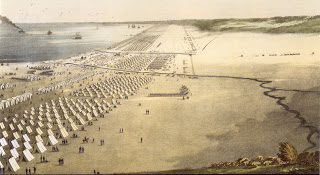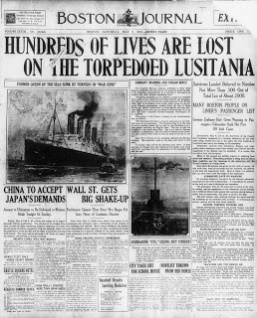“We Americans are the ultimate innocents. We are forever desperate to believe that this time the government is telling us the truth.” — Sydney Schanberg
imperialism: the policy, practice, or advocacy of extending the power and dominion of a nation especially by direct territorial acquisitions or by gaining indirect control over the political or economic life of other areas; broadly: the extension or imposition of power, authority, or influence
For some, the
Iraq invasion in 2003 seems unprecedented, as if nothing of the sort had ever happened before; and then, nearly a decade later, it happened again with
Libya in 2011. In both cases, Americans were told there was an imminent threat, and military action must be taken to stop it; in both cases, the ‘threat’ was nothing more than
fabrication (Iraq) and
exaggeration (Libya).These events are often analyzed separately, associated with the individual administrations in charge at the time. One might see the Iraq War as belonging to the “Bush administration”, and the Libya War as belonging to the “Obama administration”. Yet if one examines all of the US interventions as a whole, it becomes clear that the problem is
not one of certain administrations or individuals, but a manipulative system which has dominated American foreign policy for decades.
 |
| 4,000 US troops occupy Corpus Christi, Texas; 18461846, Mexico: US President Polk leads a national sentiment of “manifest destiny“, designed to expand federal rule from the east to west coast, including territory already occupied by natives.He offers to buy land from Mexico, but Mexico refuses. Texas, owned by Mexico, seeks US residents to “settle” there and “help grow the population”. However, these “settlers” eventually grow dissatisfied with Mexican rule and form a rebellion, thus beginning the Mexican-American War.As a result, the US gains control of Colorado, Arizona, California, Utah, Nevada, Wyoming and New Mexico. |
 1853, Japan
1853, Japan: Commodore Matthew Perry of the US Navy sails into Tokyo Harbor aboard the frigate “Susquehanna”, forcing Japan to sign a treaty permitting trade, and the opening of Japanese ports to US merchant ships.
1893, Hawaii: Hawaii has a large population of American sugar cane planters, whalers, and missionaries. In 1887, a US base at Pearl Harbor is constructed. When King David Kalakaua dies in 1891, his sister Lydia Paki Kamekeha Liliuokalani takes the throne and tries to restore Hawaii’s monarchy to absolute power. However, Hawaii Supreme Court justice Sanford Dole stages a bloodless coup backed by the US military on January 19, 1893 and dethrones the Queen, forcing her to plead with US President Grover Cleveland for reinstatement. By 1895, she abdicates the throne. President William McKinley’s administration then moves for Hawaii’s annexation, giving the US control over coaling stations in the Pacific.
Known in US history books as the “Philippine Insurrection”, it was America’s first true overseas war, lasting from 1898 to 1902.
In those 3 years, as many as 70,000 Americans die, along with close to 2 million Filipinos.
1899, Somoa: Rivalries between French, British, German, and American forces – all of which valued Pago Pago Harbor as a refueling station for coal-fired shipping and whaling – leads to the
partitioning of Somoa. The last chief of Somoa before US rule, the
Tui Manu’a Elisala, is forced to sign a deed of cession following a series of US naval trials.
1903, Panama: Seeking a canal through Panama – a province of Colombia – the US attempts negotiations and payments, all of which fail. President Roosevelt is outraged, stating that “we may have to give a lesson to these jack rabbits”. Stockholders of the New Panama Canal Company arrange a “revolution” in Panama and fund the rebels, assisted by the US Navy. Shortly after, Panama declares its independence from Colombia.
1906, Cuba: The United States assumes temporary military control of Cuba under the Platt Amendment, following the reelection of an American puppet government which caused a nationalist uprising. Two years later, the US builds a naval base at Guantanamo Bay and claims rights to it in perpetuity.
1910, Nicaragua: The US seeks to establish a canal through Nicaragua, but instead chooses Panama. When Nicaraguan President José Santos Zelaya solicits funds to build a second inter-oceanic canal for Germany and Japan, Washington turns against him. After Zelaya’s government executes two Americans for aiding anti-government rebels, Washington breaks diplomatic relations, threatens naval intervention, and forces Zelaya into exile.
1914, Mexico: Mexican officials detain several
drunken US Marines from the
USS Dolphin, which is docked in the port of Tampico, Mexico, after they accidentally enter a restricted area. The Mexican government quickly releases them and issues an apology.
Regardless of the regret expressed by Mexican President Victor Huerta, US Admiral Henry T. Mayo demands that Mexican troops salute an American flag as a sign of contrition. President Huerta refuses the salute; three days later, President Wilson orders American warships to Tampico Bay.
Wilson insists that his anger is not directed at the Mexican people, but at Huerta, “and those who adhere to him” because he refused to salute the American flag as an official apology.
By the end of 1914, US Marines had seized Tampico, forced an apology from Huerta, and demanded his resignation from power.
Tampico, Mexico was considered the
world’s largest oil port in 1901. Some of the richest oil fields were discovered within a 100-mile radius of the port between 1914-1918.
1914, Europe: The United States claims to be neutral as Germany, France, and Britain engage in conflict; however, US banks and weapons manufacturers continue selling to France and Britain, leading to the German sinking of the ship,
Lusitania, and eventual US entry to World War 1.
1917, Russia: Woodrow Wilson funds the “White” side of the Russian civil war. In the summer of 1918, he authorizes a naval blockade of the Soviet Union to help stop the Russian Revolution. American forces penetrate westward from Vladivostok to Lake Baikal, supporting Czech and White Russian forces.
The White Russian forces disintegrate by 1920, and this intervention helps fuel anti-western sentiments throughout Russia during the Cold War years.
1924, Honduras: Civil war breaks out after liberal president Rafael Lopez Gutierrez establishes a dictatorship. The US lands Marines in the country to “protect its interests”. Gutierrez is killed in March, and the revolution ends in May.
Concluded the
United States Strategic Bombing Survey of 1946, “air supremacy over Japan could have exerted sufficient pressure to bring about unconditional surrender and obviate the need for invasion. Based on a detailed investigation of all the facts, and supported by the testimony of the surviving Japanese leaders involved, it is the Survey’s opinion that … Japan would have surrendered even if the atomic bombs had not been dropped, even if Russia had not entered the war and even if no invasion had been planned or contemplated.”
1950, Korea: Without the approval of Congress, President Harry Truman sends troops to fight in
Korea, asserting an inherent right to do so as Commander-in-Chief.
The Korean War ends
three years later, leaving behind 33,600 American casualties, 16,000 UN-allied, 415,000 South Korean, 520,000 North Korean, and an estimated 900,000 Chinese.
1954, Guatemala: Jacobo Árbenz Guzmán, the democratically-elected President of Guatemala, issues land reforms which threaten the interests of US-based
United Fruit Company. CIA Director Allen Dules, along with his brother, both have stakes in the company. It heavily lobbies the US government to take action. Shortly after, the CIA begins training rebels, and sets up a radio station across the border led by fake rebels to instigate a revolution. Eventually, the Guatemalan President is sent into exile.
1961, Cuba: US mercenaries depart Nicaragua and invade Playa Girón, Cuba. They suffer a historical defeat known as the “Bay of Pigs.”

1961, Iraq: Abdel Karim Kassem, leader of Iraq, threatens western oil interests, causing the US and Britain to begin arming Kurdish rebels in the country. In 1963, Kassem is forced out of power, put on trial, and eventually shot to death. By 1968, Saddam Hussein takes power in the country, backed by the CIA. |
|
1964, Vietnam: The
USS Maddox is gathering intelligence off the coast of North Vietnam when a group of North Vietnamese torpedo boats approach the ship. The Maddox opens fire, the North Vietnamese respond with torpedoes, but they are eventually driven away. The exchange prompts the US government and
news media to report that North Vietnamese torpedo boats launched an “unprovoked attack” against the Maddox while it was on a “routine patrol”.
Two days later, Captain John J. Herrick of the USS Maddox sees two “mysterious dots” on his radar screen, determines they are torpedo boats, and sends an emergency cable to headquarters in Honolulu reporting that the ship is under attack.
Shortly after, Herrick sends another
cable: “Freak weather effects on radar and over eager sonar men … No actual visual sightings by Maddox. Suggest complete evaluation before any further action taken.”
Less than an hour later, Herrick sends a third cable, saying he is now uncertain of what had happened; however, by this time, President Johnson is already announcing a major military escalation in Vietnam.
By the end of the Vietnam War, millions of Vietnamese civilians perish, along with more than 50,000 US soldiers.
1970, Cambodia: President Richard Nixon announces that US troops are invading Cambodia, the country west of Vietnam through which the North Vietnamese are allegedly supplying their troops. For more than a year prior to the announcement, the US had been conducting bombing raids in the country.
1985, Nicaragua:
. Congress authorizes $38 million over two years in “non-military” aid to Nicaragua’s Contras.
1986, Libya: Islamic militants bomb a Berlin discotheque, killing two American soldiers. The White House uses this opportunity to retaliate, and President Reagan authorizes the bombing of Libya without the authorization of Congress. At least
100 civilians are killed.
1990, Iraq: In
August, US fighter jets, aircraft carriers, battleships, and half a million American troops are deployed to Saudi Arabia to defend against a possible attack from Iraq. Between its own oil fields, and those of Kuwait and Saudi Arabia, western governments allegedly fear Iraq could gain control over the majority of the world’s oil reserves. Dick Cheney secures the US-Saudi occupation agreement, ensuring there will be no set withdrawal date from Saudi Arabia, thereby
allowing US forces to remain.
Iraqi leader Saddam Hussein eventually annexes Kuwait, triggering the first Iraq War.
Kuwait had been part of the Ottoman Empire province of Basra, and included much of modern-day Iraq. Up until that point, Iraq had not recognized Kuwait’s sovereignty, and the border between Iraq and Kuwait had never been clearly defined.
The US. ambassador to Iraq, April Glaspie, claims that when she gave Iraq indications that the US would not oppose an invasion of Kuwait, she did not expect Iraq to take “
all of Kuwait“.
There are indications that basic infrastructure is deliberately targeted during this campaign. For example, a statement by Lt. Gen. Michael Short, US Air Force, quoted in the
Washington Post,
May 1999, reads: “If you wake up in the morning and you have no power to your house and no gas to your stove and the bridge you take to work is down and will be lying in the Danube for the next 20 years, I think you begin to ask, ‘Hey, Slobo, what’s this all about? How much more of this do we have to withstand?’ And at some point, you make the transition from applauding Serb machismo against the world to thinking what your country is going to look like if this continues.”

2001, Afghanistan: Over the summer, negotiations between western oil companies and the Afghan Taliban to build a pipeline across the country fall through. Niaz Naikm (former Foreign Secretary of Pakistan)
reveals that senior American officials told him during this time that military action to overthrow the Taliban in Afghanistan is planned to occur “before the snows [starts] falling in Afghanistan, by the middle of October at the latest”. After 9/11, this objective is realized.
2010, Pakistan: US Predator drones begin attacking targets along the Afghan-Pakistan border, killing dozens of civilians in the process.
2010, South Korea: On the evening of March 26, 2010, the Cheonan, a South Korean ship, is conducting a routine naval patrol when an explosion unexpectedly tears into it, splitting the vessel in half and killing 46 sailors. Shortly after, western powers blame North Korea for the attack, though North Korea denies responsibility. The attack gives the United States an opportunity to prolong its control over South Korean forces until 2015, and also extend its stay at nearby Japanese military bases.
Two years prior, Gaddafi planned to
nationalize Libya’s oil reserves, the largest in Africa.
August 2012: Obama authorizes the CIA to fund al-Qaeda-linked Syrian “rebels” in an effort to overthrow the Syrian government.


 1853, Japan: Commodore Matthew Perry of the US Navy sails into Tokyo Harbor aboard the frigate “Susquehanna”, forcing Japan to sign a treaty permitting trade, and the opening of Japanese ports to US merchant ships.
1853, Japan: Commodore Matthew Perry of the US Navy sails into Tokyo Harbor aboard the frigate “Susquehanna”, forcing Japan to sign a treaty permitting trade, and the opening of Japanese ports to US merchant ships.













![Muammar-Gaddafi-Libyan-le-007[1]](https://theleftyouth.files.wordpress.com/2014/12/muammar-gaddafi-libyan-le-0071.jpg?w=840)
